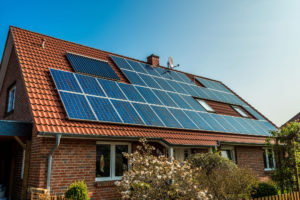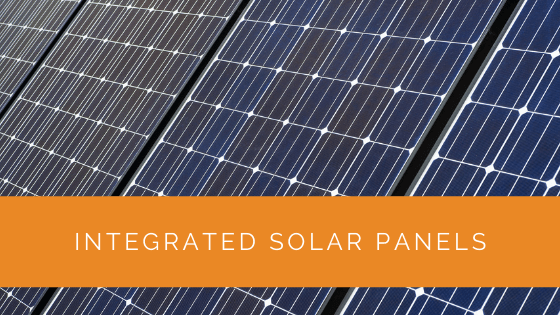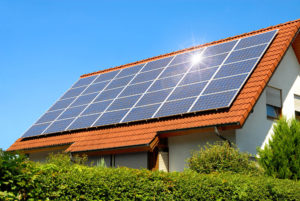Solar energy is one of the world’s biggest, most effective renewable energy sources. Solar panels give us a greener alternative to other forms of energy and power, such as central heating, and help reduce our carbon footprint whilst operating.
A solar PV panel, also known as a photovoltaic system (solar PV system), uses semiconductor technology to convert energy from the sunlight to produce energy and generate electricity and sometimes even excess electricity that can power your household.
The solar cells are made of semiconductors like silicon, connected electrically and packed in a single frame, known as a solar panel. A connection of multiple solar panels is called a solar array.
Solar panels are no longer oversized or bulky. They are now designed aesthetically. Integrated solar panels give users high efficiency and a modern, sleek look.
Contents
- 1 Key Takeaways
- 2 What are Integrated Solar Panels?
- 3 Solar Panels – How Do They Work?
- 4 Pros of Integrated Solar PV Panels
- 5 Cons of Integrated Solar PV Panels
- 6 Can You Get Integrated Solar Panels in the UK?
- 7 FAQs
- 8 Case Study: Installing Integrated Solar Panels on a Heritage Property
- 9 Expert Insights From Our Solar Panel Installers About Integrated Solar Panels
- 10 Discover the Power of Solar with Solar Panels Network
- 11 Conclusion
Key Takeaways
- Integrated solar panels, also known as in-roof solar panels, are designed to blend seamlessly with a roof’s structure, improving aesthetics and reducing the overall cost of installing solar panels, making them an attractive option for new builds and roof replacements.
- These integrated panels are lightweight, making them suitable for older and delicate architecture, and they often meet planning permissions for listed buildings or protected areas due to their customizable appearance.
- While integrated solar panels offer low maintenance and aesthetic appeal benefits, they are slightly less efficient (around 5-10%) than traditional solar panels. They can be more complex to retrofit onto existing systems. Various UK-based companies offer integrated photovoltaic panels for consumers interested in this technology.
What are Integrated Solar Panels?
Integrated solar panels are commonly known as in-roof solar panels. They are similar to conventional solar panels installed on top of slates or roof tiles, but these are integrated into the roof instead. They replaced a section of the roof with no tiles under it.
Integrated solar panels are designed to be as strong as the normal roof tiles and be weatherproof, but also include photovoltaic cells or PV cells to produce electricity for homes.
Often referred to as solar roof tiles, roof-integrated solar panels are not designed to look like roof tiles and are not generally a complete roof systems solution.
Solar Panels – How Do They Work?
- Sunlight is converted into DC electricity through solar panels.
- This DC electricity is wired through a DC switch.
- It goes through a solar inverter to convert this electricity from DC to AC.
- The use of solar battery storage is optional.
- From the solar inverter, AC electricity now flows through an electricity meter.
- Moving forward from the electricity meter, this AC electricity now goes to the fuse box from where it enters into the household’s electricity system.
- Solar electricity can finally be used to power appliances and lights for household purposes.
- The excess unused or stored electricity can then be fed to the grid.
Pros of Integrated Solar PV Panels
Aesthetics
The in-roof solar panels are known for their bulkiness and non-aesthetic appeal, and while the newer models are more modernized in design, the integrated solar panels are a step further. Since they’re installed as a part of the roof structure, they sit tight with the tiles and blend with the roof space more seamlessly. Tiles aren’t required under an in-roof system. Since this kind of solar system is installed as part of a roof’s structure, the roof-integrated system has solar panels sitting snugly with the roof’s tiles and blending in more seamlessly.

Lower Cost of Installing Solar Panels
As newer technology has become more popular and more manufacturers are offering integrated solutions, the costs of solar panels have decreased considerably compared to roof panels. An integrated solar system is more cost-efficient than a total solar roof replacement. Integrated solar panels are quite affordable, unlike the more expensive on-roof panels.
New Builds & Roof Replacements
Roof-integrated panels are best suited for roof replacements or new building projects and can be retrofitted. That is because the panels are installed simultaneously as roof tiles, meaning that technicians or roofers installing solar tiles won’t have to walk on the finished panels. However, since integrated systems are not placed on top of tiles, they are lightweight and do not require a mounting frame.
Restricted Planning Permission
Integrated solar panels are designed so that you can alter them to match certain colour schemes and sit flat with the roof. They are more likely to meet the planning permission in listed buildings or protected areas. They are lightweight, do not add to the roof’s weight, and are better for older and delicate architecture.
Low Maintenance
Solar panels are already low-maintenance, but integrated panels go further. Since integrated solar panels don’t have a mounting frame, there’s no room for birds to nest underneath.
Cons of Integrated Solar PV Panels
Lower Efficiency
One key disadvantage of integrated solar panels is that they are around 5-10% less efficient when generating energy than traditional solar panels. It happens because, unlike the on-roof solar panels, integrated panels fit in a tray rather than mounted on brackets, meaning there’s less air ventilation around the panel to help keep it cool. This lack of ventilation can lead the panels to overheat and generate less electricity on extremely hot days.
Retrofitting is Complex
Retrofitting or adding panels onto an existing solar PV system is possible with integrated solar panels, but also complex. It implies that installation will take longer than usual and be more expensive.
Can You Get Integrated Solar Panels in the UK?
Yes, manufacturers have been selling integrated photovoltaic panels widely across the country. There are plenty of UK-based companies to choose from, which include:
- GB Sol: A Wales-based solar manufacturer, GB Sol has over 20 years of expertise in the solar industry, and their roof-integrated systems have won many awards. GB Sol offers products that can be more expensive.
- GSE Integration: GSE supplies panels in the UK; the materials used are 100% recyclable! It is on the cheaper end of the price spectrum.
- Viridian: This Cambridge-based company’s system has five solar panel kits suitable for all roof styles.
- Romag: Their roof-integrated solar panels work with all types of roof covering, including clay, slate, concrete tiles, or a ‘whole roof’ solution.

FAQs
Is an Array Worth the Investment?
Due to the high price of electricity and a 25% fall in solar panel prices since 2014, an array is worth the investment. An ordinary house with up to 3 residents can easily cover its electricity costs with a 3kW solar panel system.
What System Ensures Electricity?
Grid-connected systems use a local utility grid to ensure we are never without electricity.
Are Solar Batteries Required in Solar Panel Systems?
Adding solar batteries to the system can reduce your reliance on an energy supplier. Thus increasing energy savings, reducing energy bills even further, and making your energy efficient.
How Many Types of Solar Panels Are There?
There are two types of panels:
- The electricity-producing PV or photovoltaic panels
- The heat-generating solar thermal panels
Case Study: Installing Integrated Solar Panels on a Heritage Property
Background
The Solar Panels Network was approached by a client looking to renovate a heritage-listed property while incorporating modern renewable energy solutions. The primary challenge was to integrate a solar energy system that would comply with strict heritage preservation guidelines, ensuring the installation would not detract from the building’s historic appearance.
Project Overview
The project aimed to install integrated solar panels that would provide sufficient energy for the household while maintaining the property’s aesthetic integrity. The solution needed to balance efficiency, aesthetics, and compliance with local planning regulations.
Implementation
- Site Assessment and Planning: A thorough assessment of the roof’s structure and available space was conducted to determine the optimal layout for the integrated solar panels. This involved detailed measurements and consultations with heritage preservation experts.
- Panel Selection and Customisation: High-quality integrated solar panels were chosen for their aesthetic appeal and efficiency. The panels were customized to match the roof tiles’ colour and texture, ensuring a seamless blend with the existing roof structure.
- Installation Process: The integrated panels were installed in place of traditional roof tiles, fitting flush with the roof surface. This method not only preserved the building’s aesthetic but also provided weatherproofing comparable to the original roofing materials.
- System Integration and Setup: An efficient inverter and battery storage system were installed to manage and store the energy generated. This setup ensured that the household could maximize the use of solar energy, even during less sunny periods.
- Monitoring and Optimisation: A monitoring system was implemented to track energy production and consumption in real-time. This system allowed for the ongoing optimization of the solar energy system’s performance, ensuring the best possible energy output.
Results
- Aesthetic Integration: The integrated solar panels were seamlessly incorporated into the roof, meeting heritage guidelines and preserving the building’s historic charm.
- Energy Production: The system efficiently generated enough energy to meet the household’s needs, with any excess being stored or fed back into the grid.
- Cost and Environmental Benefits: The installation resulted in significant energy cost savings and reduced the property’s carbon footprint, aligning with the client’s sustainability goals.
Summary
This case study illustrates the successful implementation of integrated solar panels in a heritage-listed property, demonstrating their suitability for projects where aesthetics and compliance are critical. The project highlights the potential of integrated solar solutions to provide both energy efficiency and visual harmony, offering a sustainable choice for historic and architecturally sensitive buildings.
Expert Insights From Our Solar Panel Installers About Integrated Solar Panels
Integrated solar panels are a fantastic solution for those looking to maintain the aesthetic integrity of their homes while still benefiting from solar energy. They blend seamlessly with the roof, providing a clean and modern look without compromising on functionality.
Lead Solar Panel Installer
One of the great advantages of integrated solar panels is their lightweight nature, which makes them suitable for a wider range of buildings, including older structures that may not support the weight of traditional panels.
Solar Energy Specialist
While integrated solar panels are slightly less efficient than traditional ones, the difference is marginal and often outweighed by the aesthetic and practical benefits they offer, especially in areas with strict planning regulations.
Renewable Energy Consultant
Discover the Power of Solar with Solar Panels Network
Are you navigating the world of solar installations? Look no further than Solar Panels Network, the UK’s trusted partner in harnessing the sun’s potential. Our dedication goes beyond just installations; we’re on a mission to transform how homeowners and businesses across the UK perceive and utilise energy. By choosing us, you’re reducing your carbon footprint and making a smart financial move that promises savings for years ahead. Contact us today and embark on your solar journey.
Conclusion
Most companies offer free solar panel quotes. But the total cost of panels depends on how many panels you need for your home, which depends on your energy consumption. You can recover this cost in the long run as the Solar Trade Association has argued that households be paid a fair market rate for the solar power they contribute to the solar electricity system, just as all other generators are.
That, in turn, will lead to solar panels becoming an additional income source for households. If you want to generate electricity with solar technology, integrated solar panels are the way. You can also sell your surplus electricity generated and sell it to suppliers.
Solar panels are the way to a bright and sunny future where you can save money on more electricity bills and reduce carbon emissions by 13%.
About the Author
Solar Panels Network stands at the forefront of solar energy solutions, driven by a team of seasoned solar engineers and energy consultants. With over decades of experience in delivering high-quality solar installations and maintenance, we are committed to promoting sustainable energy through customer-centric, tailored solutions. Our articles reflect this commitment, crafted collaboratively by experts to provide accurate, up-to-date insights into solar technology, ensuring our readers are well-informed and empowered in their solar energy decisions.


